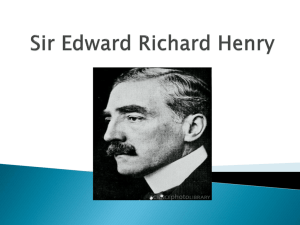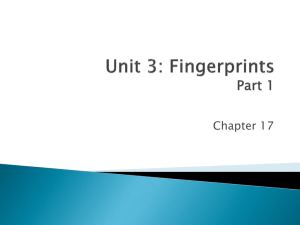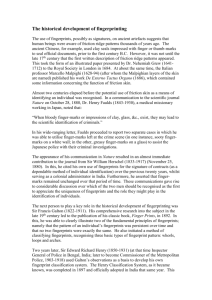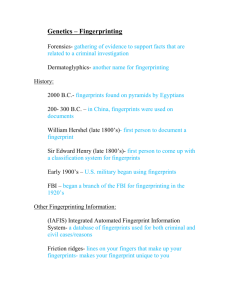history and introduction
advertisement
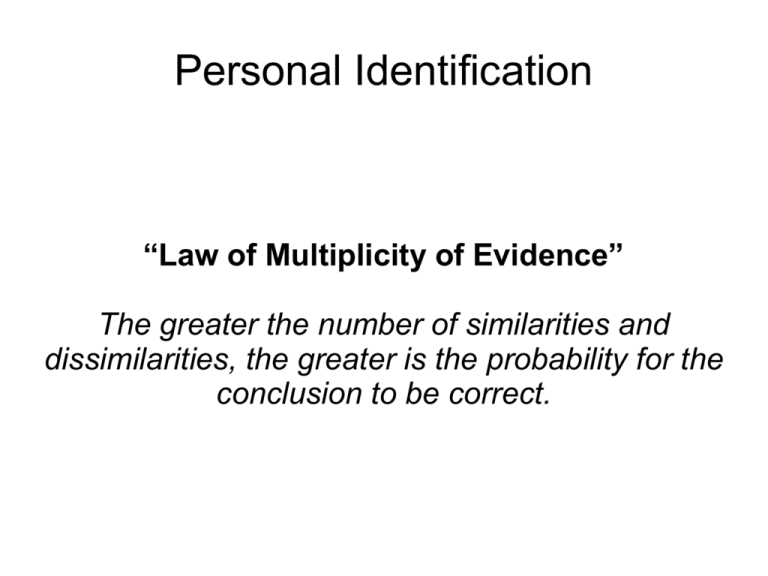
Personal Identification “Law of Multiplicity of Evidence” The greater the number of similarities and dissimilarities, the greater is the probability for the conclusion to be correct. Early Method of identification Tatooing Maiming Alphonse Bertillion Father of Personal Identification 1882, became head of the identification service in the office of the Prefect of Police Spread a new system of identification called anthropometry Combined portrait parle with anthropometry Anthropometry Anthropometry is a very old science which relates to the measurement of body dimensions. These may be: lengths (e.g. the length of the thigh bone or femur), breadths (e.g. the width across the shoulders, the biacromial breadth), girths (e.g. waist circumference) common measurements ( e.g. stature or height and mass or weight) measurement of skinfold thickness at various sites on the body (e.g. at the back of the upper arm, tricep skinfold). Portrait Parle Literally means 'word picture' Method of describing people verbally Included in Bertillion's identification system Foundation of present-day description of criminals and non-criminals Will West and William West 1903 US Penitentiary at Leavenworth, Kansas Almost exact Bertillion measurements History of Fingerprint Picture writing of a hand with ridge patterns was discovered in Nova Scotia. In ancient Babylon, fingerprints were used on clay tablets for business transactions. In ancient China, thumb prints were found on clay seals. They referred to it as Hua Chi (Ki and Io) In 14th century Persia, various official government papers had fingerprints (impressions), and one government official, a doctor, observed that no two fingerprints were exactly alike. Nehemiah Grew 1684 Philosophical Transaction presented in Royal Society of London, England Described the ridges and pores of the hands and feet Govard Bidloo Studied sweat pores and ridges Marcelo Malpighi Father of Dactyloscopy 1686 Professor at University of Bolognia, Italy Written “De Externo Tactus Organo” Discovery of Epidermis and Dermis layer Malphigi layer JCA Mayer 1788 Anatomiche Kuphertafeln First to state that fingerprints are never duplicated in two persons Johannes Purkinje 1823 Professor at University of Breslau, Germany Established a classification system of fingerprints Identified 9 type of patterns Did not associate fingerprints with identification Herman Welcker Took his own fingerprint twice with a lapse of 41 years and showed the ridge formation remains the same William Herschel 1858 Chief Magistrate of the Hooghly district in Jungipoor, India First to advocate the use of fingerprints as substitute for signature among Indian natives to avoid impersonation Based on superstition rather than personal identification Rajyadhar Konai – local businessman, first person that Herschel took the palm print of Henry Faulds 1870's British Surgeon-Superintendent of Tsukiji Hospital in Tokyo, Japan Credited with first fingerprint identification of a greasy fingerprint left on an alcohol bottle Took up the study of "skin-furrows" after noticing finger marks on specimens of "prehistoric" pottery Published an article in the Scientific Journal, "Nature" Fingerprint as means of personal identification Use of printer's ink Gilbert Thomson 1882 U.S. Geological Survey in New Mexico Used his own thumb print on a document to prevent forgery First known use of fingerprints in the United States Mark Twain 1883 Samuel L. Clemens Life of the Mississippi a murderer was identified by the use of fingerprint identification Pudd'n Head Wilson there was a dramatic court trial on fingerprint identification Francis Galton 1888 First classification system Developed the Arch, Loop and Whorl patterns as general classification Identified 9 types of patterns First to establish a Civil Bureau of Personal Identification Minutia or Galton details Stated that the possibility of having two fingerprints alike is 1:64,000,000,000 1891 Juan Vucetich Argentine Police Official, began the first fingerprint files based on Galton pattern types System was accepted in most Spanish Speaking countries At first, included fingerprint with the Bertillon System files 1892 First criminal fingerprint identification Francis Rojas-murdered her two sons and cut her own throat (left a bloody mark at the post) Haque and Bose June 12, 1897 Council of the Governor General of India approved a committee report that fingerprints should be used for classification of criminal records Calcutta Anthropometric Bureau became the world's first Fingerprint Bureau Khan Bahadur Azizul Haque and Rai Hem Chandra Bose Indian fingerprint experts credited with primary development of the Henry System of fingerprint classification Edward Richard Henry Father of fingerprint Developed the Henry System of Classification at Scotland Yard Accepted by almost all English-speaking countries Published book "The Classification and Use of Fingerprints" Edmond Locard 12 point system Wrote that if 12 points (Galton's Details) were the same between two fingerprints, it would suffice as a positive identification




